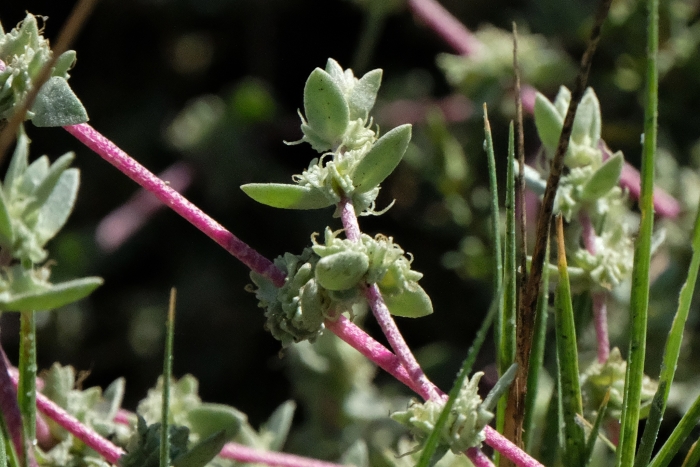Watson’s Saltbush
(Atriplex watsonii)
Watson’s Saltbush (Atriplex watsonii)
/
/

Madeleine Claire
CC BY 4.0
Image By:
Madeleine Claire
Recorded By:
Copyright:
CC BY 4.0
Copyright Notice:
Photo by: Madeleine Claire | License Type: CC BY 4.0 | License URL: http://creativecommons.org/licenses/by/4.0/ | Rights Holder: Madeleine Claire | Publisher: iNaturalist | Date Created: 2021-09-22T11:48:48-07:00 |

















Estimated Native Range
Summary
Atriplex watsonii, commonly known as Watson’s saltbush or Watson’s orach, is a perennial herb adapted to the saline soils of coastal habitats, including salt marshes, coastal bluffs, and beach scrub, often found alongside saltgrass in California and Baja California. It typically forms tangled mats of slender stems, rarely exceeding 3 feet in height, but can spread up to 10 feet wide. The plant’s foliage is a distinctive gray-green to whitish color, contributing to its unique appearance in coastal plant communities.
Watson’s saltbush is valued for its ability to thrive in high-salinity environments, making it an important species for coastal restoration and erosion control projects. It is also used in xeriscaping due to its low water requirements. The plant is dioecious, with male flowers appearing in clusters or spikes and female flowers in small clusters in leaf axils. While it is not known for showy flowers, its foliage provides a subtle aesthetic appeal. In cultivation, it prefers full sun and well-drained soils, and once established, it is highly drought-tolerant.CC BY-SA 4.0
Watson’s saltbush is valued for its ability to thrive in high-salinity environments, making it an important species for coastal restoration and erosion control projects. It is also used in xeriscaping due to its low water requirements. The plant is dioecious, with male flowers appearing in clusters or spikes and female flowers in small clusters in leaf axils. While it is not known for showy flowers, its foliage provides a subtle aesthetic appeal. In cultivation, it prefers full sun and well-drained soils, and once established, it is highly drought-tolerant.CC BY-SA 4.0
Plant Description
- Plant Type: Shrub
- Height: 0.5-1.5 feet
- Width: 0.5-1.5 feet
- Growth Rate: Moderate
- Flower Color: Green
- Flowering Season: Spring, Summer, Fall
- Leaf Retention: Deciduous
Growth Requirements
- Sun: Full Sun
- Water: Medium, High
- Drainage: Medium, Fast
Common Uses
Drought Tolerant, Erosion Control, Low Maintenance, Salt Tolerant
Natural Habitat
Native to saline soils of coastal habitats, including salt marshes, coastal bluffs, and beach scrub in California and Baja California
Other Names
Common Names: Watson’s Saltbush
Scientific Names: , Atriplex watsonii, Atriplex decumbens, Obione decumbens,
GBIF Accepted Name: